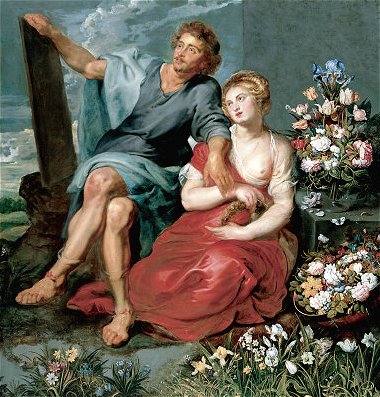 |
|
PAUSIAS AND GLYCERA
Peter Paul Rubens (figures) Flemish
1577-1640
Oaias Beert the Elder (flowers) Flemish 1580-1623/24
SN 219 Oil on Canvas 1612-15
by Robert Anderson
ARTISTS
Peter Paul Rubens, along with the Italian sculptor Gianlorenzo Bernini,
was one of the greatest artists of the 17th century. His canvases can be said to define
the scope and style of High Baroque painting through their energy, earthy humanity and
inventiveness. A devoutly religious man, a man of learning and a connoisseur of art and
antiquities, he was also a man of the world who succeeded not only as an artist but as a
respected diplomat in the service of Isabella and Albrecht of the Spanish Netherlands.
Travels to Venice where he studied Titian, Veronese & Tintoretto
freed his artistic talent from rigid classicism. While he did incorporate copies of
classical statues in his paintings he always avoided the appearance and coldness of stone.
To the contrary, his nudes, for which he became famous, always depicted an ample female
form of vitality and good health as well as of sensuousness. |
His mastery of color along with his knowledge of antiquity is seen particularly in his
mythological paintings.
Rubens became the most influential figure in Baroque art in Northern
Europe. His reputation was established in part thru the sheer scale and grandeur of his
finished paintings which gave them an extra symphonic dimension. His mastery of history
painting in the Grand Manner and the immense vigor of his style was unsurpassed.
As court painter and confidant to the Archduchess Isabella Clara
Eugenia, Rubens recognized the role art was to play in the Counter Reformation. His genius
found expression in his designs for the Triumph of the Eucharist tapestries which he and
his assistants completed between 1625 and 1628.
Knighted by two monarchs and master of a successful workshop, Rubens
became rich and famous in his own time. Having executed over 3,000 paintings, woodcuts and
engravings of all types, he died the most respected artist of his time in 1640.
Oaias Beert the Elder was an outstanding Flemish painter of still life and flower pieces.
Beert became a master in Antwerp in 1602 and also carried on a business as a cork
merchant. In addition to paintings of flowers he was especially known for his paintings of
oysters where the colors and textures of these and other crustaceans were perfectly
captured in simply arranged compositions.
SUBJECT
There have been, over the years, various thoughts regarding the figures
in this painting. At one time they were thought to be portraits of Rubens and his first
wife, Isabella Brandt. At this time, however, there is general agreement as to their
identification being that of "Pausias and Glycera".
Pausias was a famous fourth century Greek artist well known who was in
love with a fellow townswoman named Glycera who was particularly gifted in the making of
floral wreaths. Pausias was the first to master an illusionistic painting technique. He
employed his skill to reproduce Glycera's floral compositions with great exactness.
This youthful couple may also have been created as an idealized double
portrait
of Rubens' brother Philip and his wife or as an allegory of a Scholar Inspired by Nature.
PAINTING
Pausias is seated beside Glycera on a bank with his left arm on her
shoulder. It appears by his attitude that he is directing the lady's attention to some
distant object. He holds a thin rectangular object , probably a folio, in his right hand.
A vase and a basket of flowers are by the side of the lady. These accessories and the
landscape are attributed to Beert.
While the amount of Rubens' involvement in the painting is
problematical there is no doubt that Rubens painted both heads in masterful male-female
contrasts of brown and blonde hair, hard and soft flesh, dark and light skin.
HISTORICAL CONTEXT
As was sometimes the practice in the 17th century, two painters
collaborated in a single work. The flowers were originally thought to be painted by Jan
Brueghel the Elder but are now believed to be the work of Aaias Beert. Because of the
great expertise of Beert, the still-life specialist Rubens employed, it is likely that the
friendly competition between Pausias and Glycera was repeated in modern terms, the viewer
being asked to compare in this painting the skills of Beert with those of Rubens. |